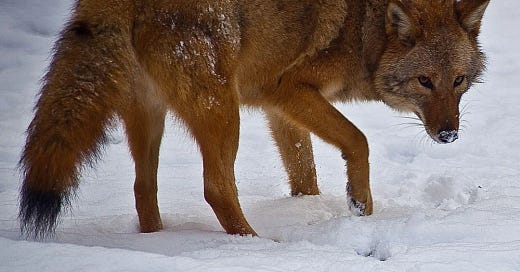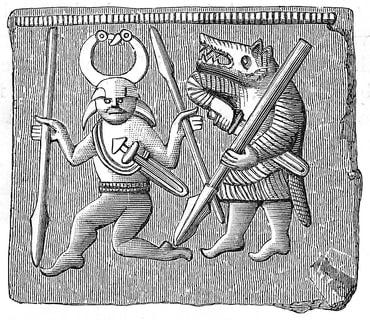We live in interesting times in many ways, and this is as true of the animal world as it is with humans. Zoologists have been researching for the last decade or so the emergence of an creature hitherto undocumented by science but now confirmed to exist. The eastern coyote (Canis Iatrans Var) is, as the name implies, endemic to the eastern parts of North America, though it has been spreading west of the Mississippi as well. They range as far north as the Canadian tundra and as far south as subtropical Florida, living in prairies, forests, swamps, suburbs, and even cities. Though not commonly seen, they are everywhere, and the story of the eastern coyote is interesting, especially considering they are not, strictly speaking, coyotes.
The eastern coyote is one of nineteen recognized subspecies of coyote, all of which are native to North America. They are similar in many ways to jackals, to which they are closely related, as they are similarly related to wolves and domestic dogs. Of the latter two, they are so close as to be able to mate with one another, though this does not occur under normal circumstances. The barriers are not biological but are related to temperament and environment; wolves, coyotes, and dogs live very different lives, and as such, the impetus to intermix simply doesn’t occur absent some external prompting.
Consider the wolf. All species of American wolves are pack hunters of large prey. They are truly wild creatures, apex predators with a ruthless hierarchy that has become a descriptive model among manosphere writers. They live far from humans if they can help it, for while men are weak as individuals, in numbers they own the land, and the wolf is nothing if not a respecter of dominance. Nonetheless, they haunt the edges of settled places, eyes glowing in the night, crouching in stillness, breathing steam into the snow as they await a stray calf or careless child to wander too far from hearth and walls. In ancient times men lived a life like theirs; they were rivals, then comrades. Then men took their young and changed them, made them creatures of hearth and walls like them, and taught them to forget the chase and the open sky. They became the pets of men as men became the pets of grain. Now men kill wolves, in the Old World as in the New.
Men fashioned dogs out of wolves the way they made spear points from stones. The dog is one of man’s oldest inventions. He is nature shaped for human use, endlessly customizable, at once an object of strong sentimental affection yet also strangely disposable. Dogs are part of the human world, of civilization, with no real place in nature. They are thus dependent on the processes of civilization, on factories to produce their processed food, central heating and air to keep them comfortable, and a huge pharmacology industry to keep them healthy. Some of them lack the ability to breed without medical aid. In behavioral terms, they are eternal children, carrying with them through life the basic mindset of a wolf cub, playing, fetching, following at the heel, tongue hanging in dependent ease. The dog is kept stunted in this way because were he to mature he would be of no use to the system. Those dogs with traits undesirable to the human system are rendered sterile with knives and chemicals, or else cast off into a lonely and dangerous internal exile.
I’ll wait a minute while you grab a tissue.
While the wolf is purely wild and the dog is purely domesticated, the coyote is, well, flexible. Wolves have very particular lifestyle, diet, and social organization. Dogs cannot live apart from men. The coyote, on the other hand, eats everything from caribou to watermelons, lives in large groups, family units, or flies solo as it suits him, and inhabits every possible ecosystem. He is a liminal animal, and it is no wonder that for the Natives of North America the coyote was a trickster, Huehuecoyotl, companion of the Lord of the Smoking Mirror. He is everywhere, unseen and watching.
This brings us to the story of the eastern coyote. As the white men of America settled the West, the West in turn settled them, and the wild places were remade in the image of the world they had left behind across the sea. This meant that wolves were shot for bounties or driven off, or in any case their prey was, and thus they disappeared from lands they had inhabited since the Ice Age. For creatures meant to live according to the ways of their ancestors, this was a catastrophe, and for some, the question became one of survival above all else. Thus wolves, unable to find mates in the usual manner, began to turn to coyotes, and produced offspring with them.
These hybrids made their way, as coyotes do, into human habitations, where they encountered dogs among the outcast and neglected. Sometimes they preyed on them, their wolf instincts making them aggressive, but their coyote nature also made them opportunists, and they in turn mated with their domesticated cousins. The offspring of these animals were even better able to maneuver in both deserts and back alleys, and in turn displaced rivals without their lineage, becoming what we know as the eastern coyote, which is in fact an amalgam of wolf, dog, and coyote. This process began in the Great Lakes region, but now encompasses the whole eastern half of the country and is growing daily.
In The Prince, chapter 18, Machiavelli notes that the centaur Chiron was the teacher of princes in Greek Myth. He offers that Chiron is in fact a kind of allegory for esoteric wisdom in that he had two natures representing the two kinds of law a prince must understand, the law of man, and the law of force or animals. The first belongs to civilization, to positive law and social convention; the second has but one commandment- kill or be killed. A prince must cultivate a sense of discernment to know when to follow which code of law, and when the latter is called for, which kind of animal to emulate. For the Florentine there were two models, the lion and the fox. The first was strong, but could not see traps, while the latter was clever, but not tough.
It is easy to admire the wolf. He is wild and fierce, untamed and proud-spirited, a creature of hierarchy and violent energy. He is, however, not without his flaws. His nature makes him predicable. It is easy to bait him, to draw him out, and kill him from afar. Like Machiavelli’s lion, he is a fighter, but not that great at sniffing out traps. As such, he only lives in places the human system has not bothered to claim for its own use, and if he leaves his reservation, he faces that system’s full wrath.
The dog, on the other hand, lacks any independent agency or ability to survive without the aid of the system. Nonetheless, he has his virtues as well. He is loyal, a companion, and above all a student of the humans among whom he lives. He understands our nature better than we do, as he is without hypocrisy or pretense, he is childlike, yes, but at once innocent and protective. There is a reason he is the choice ally of those who would maintain order both in farm and city.
The eastern coyote represents the instantiated union of these two natures, an animal wild enough to live its own way yet fully within the human world and able to take advantage of all it has to offer for its own ends. He dwells in the midst of the system but is not the system’s creature; he knows men without being known in turn. He is taking over the unseen places passed over by oblivious men, first in the Rust Belt areas abandoned by their system, now in places closer to its heart. He is unpredictable and he is dangerous. He is the animal of the future.







In a decaying society more and more humans exist in liminal space like the Eastern Coyote: the communities of our forebears are gone and we either huddle together in ill-fitting, restless and insecure groups, or find our own liminal spaces within which to dwell.
The latter skirt the encampments of the insecure herd, prowling for opportunity yet never straying too close. These have always existed in small numbers but in times of spiritual breakdown, reduced provision and loss of cohesion they can become a vital force in themselves.
Fantastic post here.
Great writing, but I think you may be missing the mark re: the inability of domesticated dogs to revert to wildness. It’s a well-worn observation in farming communities that if three dogs are allowed free rein to roam and form a pack, in 14 days they will be uncontrollable. In 30 days they will be killing your calves and lambs. That’s one of the reasons that roaming dogs are not tolerated in rural communities, and if one is observed harassing your livestock you have the legal right to put it down.